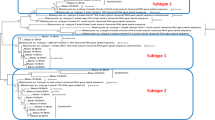Abstract
Chronic gastrointestinal illness of unknown etiology is a significant problem in the United States. Using a real-time LightCycler PCR assay we detected Blastocystis in nine patients from a metropolitan area of Corvallis, Oregon who presented with diarrhea, abdominal pain, fatigue, joint pain, skin rash and psychiatric co-morbidity. Phylogenetic analysis identified six infections with Blastocystis sp. subtype 3, and one with subtype 1, using the standard Stensvold nomenclature. Most patients with subtype 3 had previously tested negative with conventional parasitological diagnostics, had been symptomatic for over 4 years, and reported antibiotic failure.
Similar content being viewed by others
References
Amin OM (2002) Seasonal prevalence of intestinal parasites in the United States during 2000. Am J Trop Med Hyg 66:799–803
Amin O (2006) Epidemiology of Blastocystis hominis in the United States. Res J Parasitol 1(1):1–10
Hussein EM, Hussein AM, Eida MM, Atwa MM (2008) Pathophysiological variability of different genotypes of human Blastocystis hominis Egyptian isolates in experimentally infected rats. Parasitol Res 102:853–860
Jones MS, Ganac RD, Hiser G, Hudson NR, Le A, Whipps CM (2008) Detection of Blastocystis from stool samples using real-time PCR. Parasitol Res 103:551–557
Kappus KK, Juranek DD, Roberts JM (1991) Results of testing for intestinal parasites by state diagnostic laboratories, United States, 1987. MMWR CDC Surveill Summ 40:25–45
Katsarou-Katsari A, Vassalos CM, Tzanetou K, Spanakos G, Papadopoulou C, Vakalis N (2008) Acute urticaria associated with amoeboid forms of Blastocystis sp. Subtype 3. Acta Derm Venereol 88:80–81
Kaya S, Cetin ES, Aridoğan BC, Arikan S, Demirci M (2007) Pathogenicity of Blastocystis hominis, a clinical reevaluation. Turkiye Parazitol Derg 31:184–187
Li LH, Zhou XN, Du ZW et al (2007) Molecular epidemiology of human Blastocystis in a village in Yunnan Province, China. Parasitol Int 56:281–286
Low GC (1916) Two chronic amoebic dysentery carriers treated by emetine, with some remarks on the treatment of Lamblia, Blastocystis and E. coli infections. J Trop Med Hyg 19:29–34
Markell EK, Udkow MP (1990) Association of Blastocystis hominis with human disease? J Clin Microbiol 28:1085–1086
Nimri L, Batchoun R (1994) Intestinal colonization of symptomatic and asymptomatic schoolchildren with Blastocystis hominis. J Clin Microbiol 32:2865–2866
Qadri SM, al-Okaili GA, al-Dayel F (1989) Clinical significance of Blastocystis hominis. J Clin Microbiol 27:2407–2409
Ronquist F, Huelsenbeck JP (2003) MrBayes 3: Bayesian phylogenetic inference under mixed models. Bioinformatics 19:1572–1574
Scicluna SM, Tawari B, Clark CG (2006) DNA barcoding of Blastocystis. Protist 157:77–85
Silberman JD, Sogin ML, Leipe DD, Clark CG (1996) Human parasite finds taxonomic home. Nature 380:398
Stensvold CR, Arendrup MC, Jespersgaard C, Mølbak K, Nielsen HV (2007a) Detecting Blastocystis using parasitologic and DNA-based methods: a comparative study. Diagn Microbiol Infect Dis 59:303–307
Stensvold CR, Suresh GK, Tan KS, Thompson RC, Traub RJ, Viscogliosi E, Yoshikawa H, Clark CG (2007b) Terminology for Blastocystis subtypes—a consensus. Trends Parasitol 23:93–96
Stenzel DJ, Boreham PF (1996) Blastocystis hominis revisited. Clin Microbiol Rev 9:563–584
Swofford DL, Waddell PJ, Huelsenbeck JP, Foster PG, Lewis PO, Rogers JS (2001) Bias in phylogenetic estimation and its relevance to the choice between parsimony and likelihood methods. Syst Biol 50:525–539
Tyler BM et al (2006) Phytophthora genome sequences uncover evolutionary origins and mechanisms of pathogenesis. Science 313:1261–1266
Vennila GD, Suresh Kumar G, Khairul Anuar A, Rajah S, Saminathan R, Sivanandan S, Ramakrishnan K (1999) Irregular shedding of Blastocystis hominis. Parasitol Res 85:162–164
Whipps CM, Kent ML (2006) Phylogeography of the cosmopolitan marine parasite Kudoa thyrsites (Myxozoa: Myxosporea). J Eukaryot Microbiol 53:364–373
Yakoob J, Jafri W, Jafri N, Islam M, Asim Beg M (2004) In vitro susceptibility of Blastocystis hominis isolated from patients with irritable bowel syndrome. Br J Biomed Sci 61:75–77
Yoshikawa H, Yoshida K, Nakajima A, Yamanari K, Iwatani S, Kimata I (2004) Fecal–oral transmission of the cyst form of Blastocystis hominis in rats. Parasitol Res 94:391–396
Yoshikawa H, Wu Z, Howe J, Hashimoto T, Geok-Choo N, Tan KS (2007) Ultrastructural and phylogenetic studies on Blastocystis isolates from cockroaches. J Eukaryot Microbiol 54:33–37
Zierdt CH (1991a) Blastocystis hominis—past and future. Clin Microbiol Rev 4(1):61–79
Zierdt CH (1991b) Pathogenicity of Blastocystis hominis. J Clin Microbiol 29:662–663
Acknowledgments
We would like to thank Dr. Greg Hiser for many discussions about the clinical symptoms and real-time PCR.
The work reported herein was funded and performed under United States Air Force Surgeon General-approved Clinical Investigation No. FDG20070010N. This study was also funded by the Blastocystis Research Foundation. The experiments comply with the current laws of the country in which they were performed.
The views expressed in this material are those of the authors, and do not reflect the official policy or position of the U.S. Government, the Department of Defense, or the Department of the Air Force.
Author information
Authors and Affiliations
Corresponding author
Additional information
An erratum to this article can be found at http://dx.doi.org/10.1007/s00436-008-1319-3
Rights and permissions
About this article
Cite this article
Jones, M.S., Whipps, C.M., Ganac, R.D. et al. Association of Blastocystis subtype 3 and 1 with patients from an Oregon community presenting with chronic gastrointestinal illness. Parasitol Res 104, 341–345 (2009). https://doi.org/10.1007/s00436-008-1198-7
Received:
Accepted:
Published:
Issue Date:
DOI: https://doi.org/10.1007/s00436-008-1198-7




